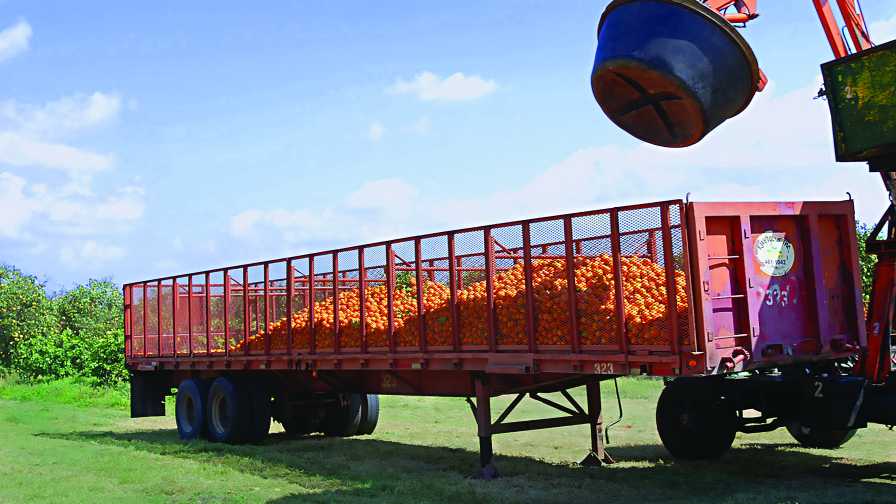Soured Season Hard to Swallow for Florida Citrus Stakeholders

Florida citrus production in 2017-2018 took a big hit from Hurricane Irma. Orange juice processors were down across the board after the storm.
Photo by Frank Giles
The double gut punch of HLB combined with Hurricane Irma left its mark in orange groves this past season. USDA’s forecast (as of this posting) puts production down by 36% from the previous season at 44.95 million boxes. The season will be a whopping 80% off the peak citrus production of the 1997-1998 season.
Juice Supplies Tight
The reduced crop brought the season to an earlier-than-normal end, as growers prepare and pray for a better season ahead. But, the ripple effects of the year were felt by more than just the growers. Orange juice processors felt the impact as well when trying to source oranges for their plants.
“It was not just the loss of boxes from the hurricane; the quality was impacted, too,” says Fran Becker, President of Arcadia-based Peace River Citrus Products. “The trees were trying to heal themselves and couldn’t keep up making enough sugars to put out roots, leaves, and fruit. We probably lost 20% from the storm, but the real losses came after the storm when the fruit continued to fall.”
Becker adds that orange juice processors were down across the board, with some being worse off than others based on their proximity to the storm’s path. The cash market for citrus helps to get a sense of the picture.
“There just isn’t a lot of fruit on the cash market anymore,” Becker says. “The Florida Department of Citrus (FDOC) post-estimate report shows you how the fruit traded after the crop estimate. The report showed that only 3% of early- and mid-season crop fruit was in the cash market. It was only 2% for Valencia. A very small amount of fruit has been traded on the cash market this year, which shows you the bulk of this crop is on long-term contracts.”
With the vast majority of the crop already committed to processors, there was very little fruit available to fill the void after the storm. Processors continue to rely on juice imports. Mexico, Brazil, and Costa Rica helped fill slack supplies. Estimates show Florida will import more than 87 million gallons of juice this season, up from roughly 78 million gallons last season.
“We are looking forward to the day when we find solutions to citrus greening, so we can hopefully supply a larger share of domestic demand with Florida juice and reduce our current levels of imports,” Becker says.
Tax Revenues Down
The FDOC has felt the pinch in its budget as well, due to the effects of Hurricane Irma. But, according to Shannon Shepp, the department’s Executive Director, adjustments have been made to work around the situation. And they are counting on a better crop to help bolster budgets next season.
“In May, FDOC proposed a preliminary budget that is essentially a continuation of the 2017-2018 season budget,” Shepp says.
Shepp expects around $400,000 to come from the additional general revenue funds received from the state and some planned reductions in administrative costs.
“The proposed preliminary budget for next season is based on a crop size of 60 million boxes of oranges, 5 million boxes of grapefruit, and 880,000 boxes of specialty citrus,” she says. “It also includes use of about $2.7 million of a fund balance (funds unspent in previous seasons).”
Shepp also says FDOC will work with state legislators to highlight the value of the citrus industry and the impact of promoting and protecting the state’s signature crop.
“We also have increased our use of the fund balance to offset reductions in crop size while maintaining programs and services,” she says.
The department has focused on unifying its global markets under one creative direction in recent years so that assets can be shared across marketing programs, according to Shepp. She says the goal of consistent branding and a cohesive message across the markets is to make Florida orange juice and grapefruit more easily recognizable to consumers.
“This not only allows us to be more effective in our consumer education, but it also helps us take advantage of efficiencies in order to be more mindful of our budget,” Shepp says.
A Silver Lining
As frustrating as the season turned out to be, Becker says we can’t forget there appeared to be an improved crop on trees before Hurricane Irma hit. And trees seem to be bouncing back better than expected in some places.
“Trees look relatively good given everything they have been through with the storm,” he says.
Five years of adjusting production programs in the fields was actually paying off, he says.
“Based on early forecasts prior to the storm, we believe we had a crop somewhere around 75 million to 80 million boxes. We were up finally,” he says. “After all this hard work, the trees were showing they can be productive with the bacteria and re-infection.”
Becker saw some promising benefits from bactericides, as well.
“The question is how well the fruit we set holds on trees for the next crop. I am cautiously optimistic we will see a better crop, but will we get to where we were before Irma? Probably not, but hopefully without any unforeseen circumstances, we can do it the following year,” he says.










